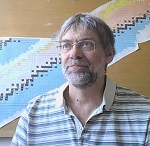Influence of sub-nanosecond time-of-flight resolution for online range verification in proton therapy using the line-cone reconstruction in Compton imaging - PDF Version
Jayde Livingstone, Denis Dauvergne, Ane Etxebeste, Mattia Fontana, Marie-Laure Gallin-Martel, Brent Huisman, Jean Michel Létang, Sara Marcatili, David Sarrut and Étienne Testa
Phys Med Biol (2021), 66, 125012, DOI: https://doi.org/10.1088/1361-6560/ac03cb
What was your motivation for initiating this study?
The favourable depth-dose characteristics of protons (relatively low entrance dose, well-defined range and highly localised dose deposition at the end of the particle track) are not fully exploited in proton therapy due to uncertainties in the proton range. Online monitoring of the proton range via, for example, the detection of secondary gamma rays emitted during treatment using a Compton camera, could lead to the use of less conservative treatment plans than are required currently. This study aimed to investigate, via Monte Carlo simulation, the effect of the temporal resolution of a Compton camera on the precision of the retrieved proton range through use of a line-cone reconstruction. The hypothesis was that, through use of a camera with a temporal resolution of the order of ~100ps, the line-cone reconstruction method could yield a precision equivalent to, or better than, what has been achieved previously using much longer iterative reconstruction methods or more complicated detector geometries.
What were the main challenges during the work?
Whilst Monte Carlo simulations can be used to model radiation transport in matter very accurately, calculation periods are often very long and resource-intensive. This is particularly pertinent when particles are tracked to low energies or when a very large number of histories is required to reduce the statistical uncertainty, as was the case for this study. We used the resources made available by the IN2P3 Computing Centre (https://cc.in2p3.fr/en/) in Villeurbanne, France, to perform the simulations and the analysis in parallel.
What is the most important finding of your study?
We present a method based on time-of-flight to “denoise” the spatial distribution of detected gamma rays and to demonstrate that a precision of ~2mm in the proton range can be achieved for a large proton beam spot through use of the line-cone reconstruction method. This method had a threshold of 100-200ps on the combined proton/gamma ray time-of-flight. This is a big improvement on the ~5mm precision that was achieved by our Compton camera prototype with a temporal resolution of 1.3ns, and it is comparable with the current state-of-the-art.
What are the implications of this research?
The results of this study are promising for the development of Compton cameras as online monitors of proton range for use in proton therapy. We have demonstrated that with a temporal resolution of ~100ps, which is achievable via the current state-of-the-art scintillator technology, a 2mm precision in the proton range, at the single beam spot scale, measured in real-time, is realistic. With ongoing optimisations of the detector design to improve the sensitivity, further improvements of the precision are expected. Routine implementation of high-precision online monitoring of the proton range in the treatment room is expected, and should lead to the use of less conservative treatment plans with improved treatment outcomes for patients.
Jayde Livingstone1,2, Denis Dauvergne1, Jean Michel Létang3, Étienne Testa2
1Université Grenoble Alpes
CNRS, Laboratoire de Physique Subatomique et de Cosmologie
Grenoble, France
&
2Université Lyon
CNRS, Université Lyon,
Institut de Physique des Deux Infinis
Lyon, France
&
3Université Lyon
CNRS, INSERM, INSA-Lyon, Université Lyon 1, CREATIS
Lyon, France

Jayde Livingstone

Denis Dauvergne

Jean Michel Létang

Étienne Testa